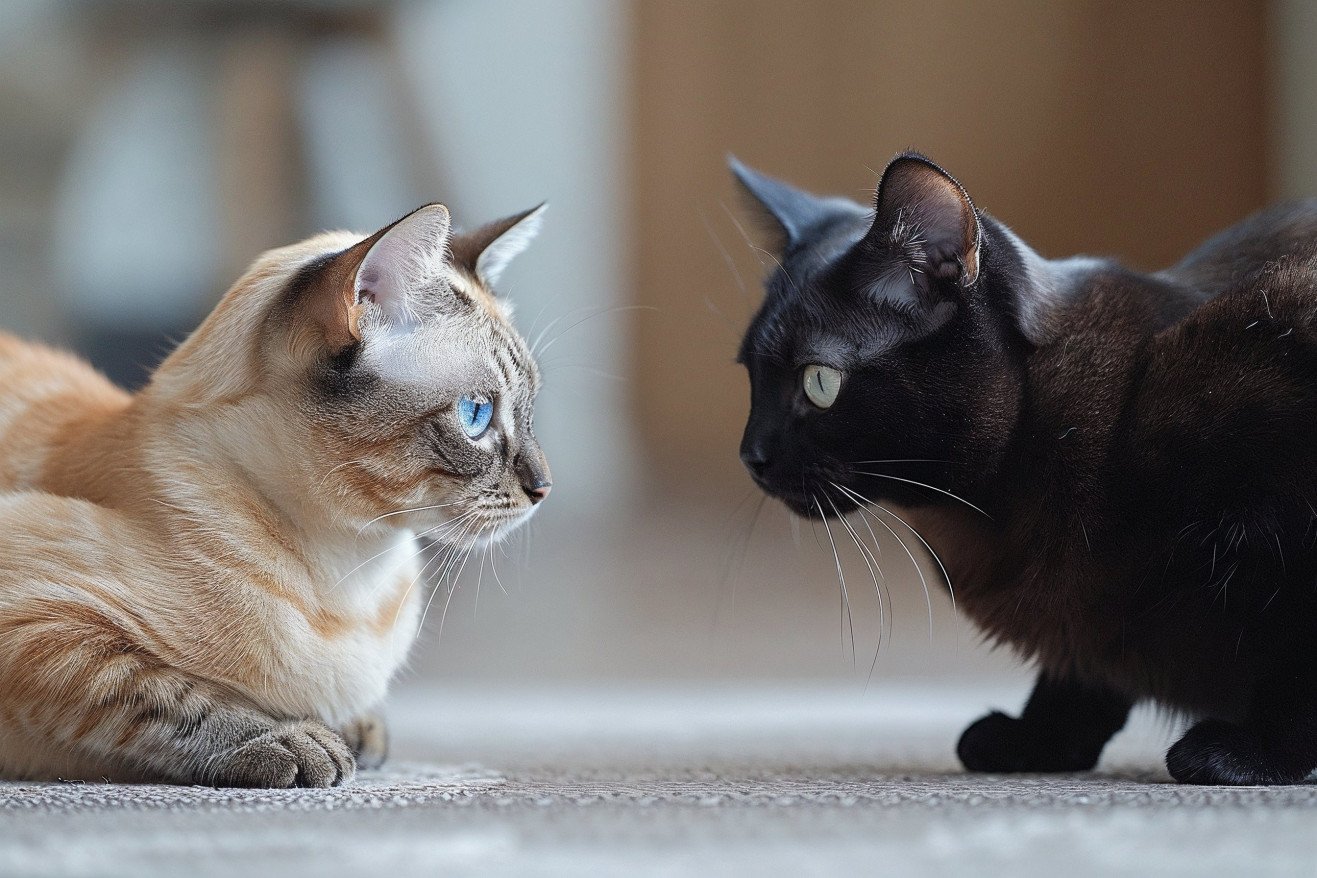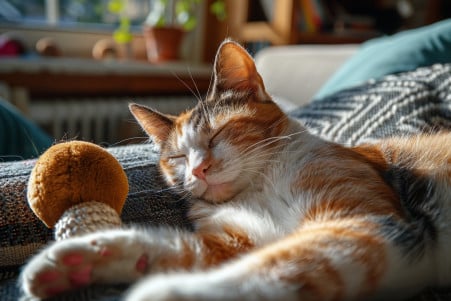Signs of Aggression When Introducing Cats: What the Experts Say
4 February 2024

Introducing a new cat to your home can feel like you’re walking on eggshells. Look for signs of aggression when introducing cats, including hiding, hissing, growling, flattened ears, and a puffed-up tail. Don’t force interactions and make sure each cat has their own space to feel safe and secure. If aggression continues, talk to your vet.
In order to help you successfully integrate your cats, we will cover information from veterinarians, animal behaviorists, and ethological and other scientific studies. We will discuss topics like how cats communicate, the effects of stress on cats during introductions, and the role that territory plays in multi-cat homes.
This information will help you better understand and recognize the signs of aggression and help you know how to deal with them, ultimately helping you successfully bring your new cat into your home and better manage the cat introduction process.
What are the most reliable indicators of aggression in cats during new introductions?
Understanding How Cats Communicate
Cats, which are known for their ability to communicate through body language, especially in stressful situations like introductions, are experts at silent communication.
A cat’s tail position and ear angle can tell you a lot about how the cat is feeling. According to Cats Protection, a cat that is ready to interact with others will show signs of relaxation, like a high, curved tail and slow blinking.
On the other hand, a cat that is scared or aggressive will have a tail that is tucked or puffed up and ears that are flat against the head, which is a clear sign that the cat is not in the mood for interaction.
The Humane Society of the United States explains that cats also communicate through a range of vocalizations, from purring to yowling, which can be especially important when it comes to cat-to-cat introductions.
It’s a common misconception that purring always means a cat is happy; cats also purr when they are anxious or in pain. This is important to know so that you can make sure to interpret your cat’s behavior correctly and not misread a defensive hiss as playful behavior.
Understanding these signs will help ensure that you can help your cat through the transition and avoid misinterpreting their behavior. This will help you make sure that you don’t mistake a defensive hiss for playful behavior.
By understanding these signs, cat owners can make sure that their home is a peaceful place, and they can be prepared to help their cats through stressful times and encourage positive interactions between their pets. As we move from the physical signs of communication to the psychological signs, it’s important to think about the psychological stress that cats can experience during these vulnerable times.
The Silent Killer: Stress and Cat Behavior During New Introductions
In addition to the stress of the new cat, the stress of the resident cat can also have a major impact on the situation. Sickness behaviors, which are behaviors that animals use to adapt to environmental changes, are often induced by stressors, according to a study published in PMC.
These behaviors can include changes in appetite, elimination, and activity, which can be a sign that more overt aggression or fear is on the horizon during introductions.
Stress also has a major impact on the body. The same study found that stress in cats led to changes in leukocyte and neutrophil counts, as well as changes in cytokine levels, which are markers of inflammation and immune response. Internal stress markers like these can lead to chronic health issues, such as feline interstitial cystitis, which is a lower urinary tract disease that is often exacerbated by stress.
It’s important for cat parents to recognize the signs of stress in their cats during introductions. By understanding the psychological effects of stress on cats, cat parents can work to create a supportive, stress-free environment for their pets. This understanding can also help researchers and veterinarians determine how pheromones and environmental enrichment can be used to reduce stress and improve the success of cat introductions.
Using Pheromones and Environmental Enrichment to Help Cats Get Along
Pheromones may not be the first thing you think of when it comes to cat behavior, but they play a huge role in how cats interact with one another. Pheromone-based products like Feliway are designed to mimic the natural pheromones that cats use to mark their environment, and Cats Protection says they can be very effective in helping cats feel safe and secure when a new cat is introduced to the home.
Environmental enrichment is another important tool that can be used in conjunction with pheromones to help cats feel more comfortable and less stressed when a new cat is brought into the home. An article published in PMC explains that environmental enrichment can help cats feel more secure by ensuring that there are enough resources to go around, such as separate feeding and litter box areas that prevent competition.
In addition, the article explains that environmental enrichment can be used to help cats feel more comfortable by providing them with activities that are stimulating and rewarding. This can include things like puzzle feeders, scratching posts, and climbing structures that allow cats to engage in natural behaviors while also getting exercise.
By using pheromones to help cats feel more secure and environmental enrichment to help them feel more comfortable, cat owners can help their pets feel more confident as they navigate the process of getting to know a new cat. This, in turn, can help ensure that the new cat introduction process goes more smoothly and that the home remains a peaceful place for all the cats involved.
Navigating the Social Maze: Introducing Cats in Multi-Cat Homes
The social structure of multi-cat households is a complicated web of relationships and territories. While cats are solitary hunters, they can live in groups if the circumstances are right.
According to International Cat Care, cats mark and defend the territories within a home, and bringing in a new cat can disrupt the social order. It’s important to know the social structure of the cats in your home, as some will have stronger relationships and a hierarchy that new cats will have to fit into.
The research review in Applied Animal Behaviour Science says that play is important for reducing stress and promoting social behavior. Play in cats mimics hunting, which not only gives them an outlet for their energy but also encourages positive interactions with other cats in the home.
In order to promote a peaceful environment, each cat should have a place to retreat to on their own, as well as a place where play can be controlled and supervised.
Strategies for managing multi-cat households include slowly introducing cats through scent swapping, managing play between cats, and ensuring that resources are available to all cats so that they don’t have to compete for them.
Observers can learn a lot about the new social structure by watching the cats’ reactions to each other. By learning to read their individual behaviors and preferences, you can learn to intervene before things get out of hand and help your cats learn to live together in peace, as described in the study “The Social Lives of Free-Ranging Cats” by Kristyn R. Vitale.
Final Thoughts on Cat Introductions
While working through the ins and outs of cat introductions, we have highlighted important red flags such as hiding, hissing, and growling that can signal stress and even aggression. Knowing these signs and understanding the nuances of cat body language is important. It can help you intervene when a cat is showing signs of feeling threatened or uncomfortable based on their body language and sounds, which can help ensure a more successful introduction.
The role of stress in cats’ behavior and health is important to note. Stress can lead to what’s known as ‘sickness behaviors,’ which, if not managed, can lead to chronic health problems. That said, there is hope: synthetic pheromones and a well-enriched environment can help reduce these stressors, making the transition easier for everyone involved.
In multi-cat homes, things get even more complicated, and it takes time and careful observation to work through. That said, balance can be achieved by respecting established territories and social hierarchies and encouraging positive interactions.
As always, it’s important to remember that every cat is an individual, and that means every introduction will be as well. However, with the information provided here and an understanding of the role of the environment and pheromones, you can help ensure a successful cat introduction.


